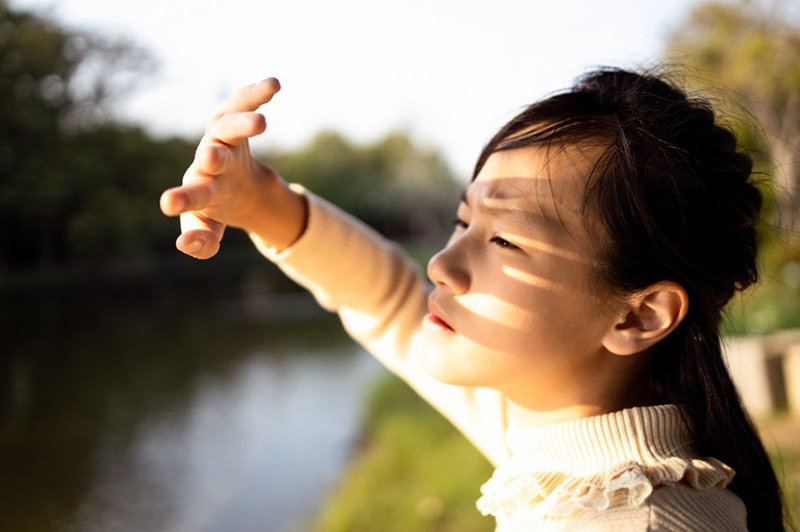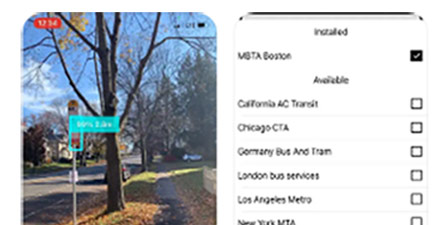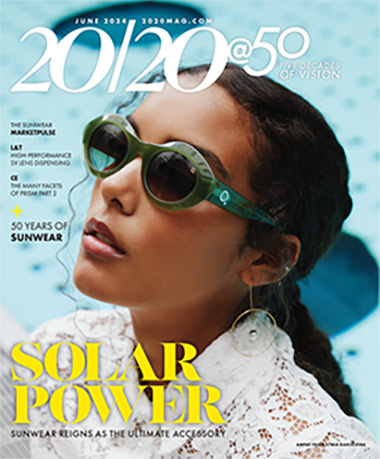
By Linda Conlin, Pro to Pro Managing Editor

As lifestyles have evolved, so has our relationship with light. Currently, people spend more time indoors exposed to artificial lighting and lights from digital devices. This shift has led to longer hours of exposure to light as we stay up late into the night, and it has contributed to more of us experiencing light sensitivity. According to the 10th annual Transitions Optical Employee Perceptions of Vision Benefits survey, eight in ten employees are bothered by vision-related symptoms at work, and light sensitivity has been linked with these symptoms. Symptoms of light sensitivity include eye strain, itching, tearing, blurring, visual tiredness, headache, heaviness of eyelids, dry eye, redness, and pain.
Three primary contributors to light sensitivity are extended exposure to sunlight, artificial light, and digital screens. Each of these sources is associated with glare that can cause discomfort and impair vision. When visible light strikes photoreceptor cells in the retina, it initiates the visual cycle, converting the light into electrochemical signals. Next, the retinal ganglion cells refine the electrochemical signals, and these signals are transported from the retina to the brain via the optic nerve. Ultimately, the light signals reach the visual cortex of the brain’s occipital lobe, which triggers a light adaptation response. Responses in certain cortical areas are higher for light sensitive people.
Tip: Identify the primary source of the patient’s light sensitivity through lifestyle questions and symptoms, to develop a solution. Remember that light sensitivity can come from several sources for that patient.
Time in natural sunlight is important to our overall health and wellbeing, but there are caveats. Prolonged exposure to intense sunlight can result in discomfort glare and/or disability glare. Discomfort glare occurs when a light source is too strong for our eyes’ adaptive mechanisms. It may cause squinting, shading, or closing the eyes because the light level is uncomfortable. Disability glare occurs when a light source reduces visual acuity. This type of glare generally reduces contrast, so that objects aren’t as easy to see against their background. What’s more, when light hits a highly reflective horizontal surface (water, wet pavement, car hood), light becomes polarized and produces blinding glare. The only way to eliminate this glare is to place a polarized lens in its path that can preferentially absorb the interfering glare. Outdoor light conditions can change frequently, too, requiring constant adaptation.
Tip: It is essential that ECPs recommend optical quality and prescription sunglasses with 100% UV protection and polarization to patients. Mirror coatings add another layer of protection. Photochromic lenses adapt to changing light conditions and are available with polarization.
We are exposed to artificial light both indoors and out. Outdoors, headlights, flashing lights, and stadium or field lights can induce discomfort and disabling glare. Indoors, high intensity, non-uniform lighting with a high blue component also results in glare. Then there are digital devices. Use of phones, tablets, and computer screens has increased dramatically in recent years. The light emitted by most LEDs appears white, but LEDs have peak emission in the blue light range (400-490 nm) which could cause discomfort from glare. According to Gary Morgan, OD, “Blue light diminishes visual quality in that its short, out of focus wavelengths reduce contrast… Glare is worsened by blue light as its short wavelengths are scattered the most intraocularly. Blue light sources such as electronic screens or the sun can worsen glare, causing discomfort or disability depending on brightness… When viewing electronic devices, myopically defocused blue light results in what is now termed digital eyestrain.” Reducing short wavelength blue light screen emissions makes it easier for our eyes to focus, increasing comfort for the prolonged time spent staring at blue emitting screens.
Tip: ECPs can educate patients about the effects of exposing the eyes to UV and high energy visible
blue light radiation. Present product options, including blue light filtering lenses and antireflective coatings, to increase comfort.
All of us are exposed to a variety of lighting conditions day and night, and ECPs need to help manage light for everyone. The constant exposure and adaptation can result in visual discomfort of varying degrees, and a loss of visual performance or light-associated discomfort can impact daily life. It’s important for ECPs to identify each patient’s source and degree of sensitivity through lifestyle questions and provide the appropriate solution.












